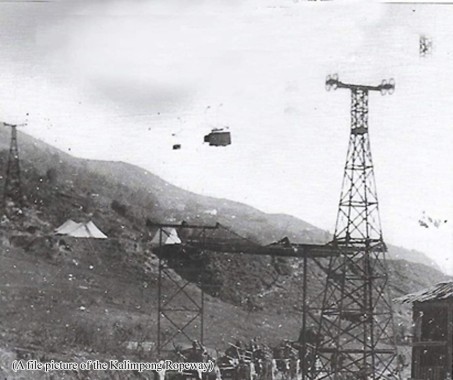




















Sunday, Jun 25, 2023 08:00 [IST]
Last Update: Sunday, Jun 25, 2023 02:32 [IST]
The Teesta Valley Branch of the Darjeeling Himalayan Railway and the Kalimpong Ropeway were and are synonymous with each other. One cannot be spoken of without mentioning the other. Both belong to that age which could, without any hesitation, be called the golden era of Kalimpong.
In the early and mid 1900’s Kalimpong was the hub of all trade that took place between Tibet proper and India. There are more than half a dozen passes that connect Sikkim and Tibet but trade between Lhasa and India that passed through the Chumbi Valley entered Sikkim either through the Nathula or the Jelepla. Although the route through Nathula Pass was a little shorter and passed through Gangtok, traders preferred to use the route through Jelepla Pass which ran into Kalimpong due to the fact this route was easier and an all weather road one. As a consequence, the volume of trade that passed through Kalimpong was immense. Thousands of mules streamed into Kalimpong during its hay days bringing thousands of tons of goods from Tibet.
These goods needed to be cleaned, sorted, repacked and then transported to the mainland of India for distribution within India and abroad. Hundreds of labourers and dozens of trading houses were involved in this process. Much of the goods were perishable items and they needed to be transported to their end destination at the earliest and in the best possible condition.
Prior to 1915 these thousands of tons of goods which arrived in Kalimpong from Tibet and Eastern Sikkim were transported to the railhead at Siliguri either on bullock-carts or on mule trains or even head-loads. After the Teesta Valley Branch of the DHR was started in the year 1915, goods from Kalimpong were transported to the Kalimpong Road Station (Giel Khola) in the same way. With further increase in the volume of trade, transportation to the Kalimpong Road Station by bullock-carts or mules or head-loads became a clumsy, time consuming and expensive affair. A much more effective mode of transport was the need of the hour and keeping this in mind the then British Rulers mooted the opening of a Ropeway that would make the transportation of goods from Kalimpong to the Railhead an easier and less expensive matter.
In 1925 a survey was made for a freight ropeway that would connect the Teesta Valley Railway line to Kalimpong. The survey report concluded that the construction of the ropeway was very much possible and that it would be extremely beneficial. It would be less time consuming and would also be less expensive. Hence the Kalimpong Ropeway Co. Ltd; was formed in the year 1928 and the London based British Ropeway Engineering Co. Ltd; was commissioned to design and construct the same. The company started with an initial authorized Capital of Rs. 5 Lakhs which was fully issued and subscribed. This Capital was later increased to Rs. 20 Lakhs to cater for any further expansions.
After the technical survey, the construction company decided that the practical base of the Ropeway would be on the Rellie River, shortly before it joined the Teesta River. This base was connected to the railhead at Riyang Railway Station which stood on the opposite end of the valley. The Kalimpong Ropeway was inaugurated in September 1930 by Lady Stephenson, wife of the then Acting Governor of Bengal. The first carrier to arrive after the inauguration brought Lady Stephenson a basket of flowers. The management of the Ropeway was entrusted to Messrs Gillanders Arbuthnot & Co; and the DHR was appointed as the Working Agent.
The Ropeway was operated in two sections- the lower section which was about 7.2 Km long ran from the Riyang Railway Station to the angled station at Nazeok after crossing the Teesta and the Rellie Rivers. The Ropeway once again crossed the Rellie River and climbed about 2500 feet up the hill to reach the Kamsi Forest Village. Kamsi is a small village to the south east of Kalimpong town. It is situated directly below the present day Army Butchery. At Kamsi, the Ropeway was powered by a 72 hp oil engine. From Kamsi the Ropeway travelled in a straight line for about 4 Km while climbing about 1600 feet to reach its base at Kalimpong. The location of the base at Kalimpong was a site next to the present day Pranami School. Another 72 hp oil engine was installed here to power the ropeway. The total time taken by a carrier to travel from Riyang Railway Station to its base at Kalimpong was about 1 hour 40 minutes.
The tallest trestle was 139 feet in height and each of these could hold a load of 10cwt ( 10 quintal or 1000kg) and with platforms designed to arrive every three minutes, almost 10 tons (about 10,000 kg) of loads could be transported per hour. The platforms travelled at a speed of 10 km per hour suspended on the wires and each platform was lowered on to the ropes at an interval of three minutes to ensure equal load distribution. The loads were carried on platforms suspended from the wire and these platforms were automatically lifted off the ropes and carried on overhead rails into each station for stacking or unloading. Each of these platforms was designed to carry a load of about 300 kg and a few could hold about 500 kg.
Kalimpong Ropeway changed the way trade was carried out through Kalimpong. It revolutionized trading in the region and the volume of trade increased manifold. It proved to be a very efficient and cost effective mode of transportation. Before the ropeway came into being the coolies or bullock-carts charged between Rs. 1.00 to Rs. 4.00 per maund (about 38kg) depending on the type of goods and the time of the year. This charge was from Kalimpong bazaar to the Kalimpong Road Station.
The ropeway levied charges depending on the type of goods to be transported but the charges never exceeded 40 paise per maund all year around. The added advantage was that the ropeways transported goods to the Riyang Railway station which was 6 km further away from the Kalimpong Road Station meaning a further saving for the traders.
An extension of the ropeway was made with its base next to the freight yard at Pranami School. This ropeway extended to the Dr. Graham Homes complex and the base at this end was near the present day workshop within the school campus.
In the year 1939 a fire destroyed the freight yard and station in the upper section of the Ropeway. Almost all the goods stocked here as well as almost all of the Station was gutted in this devastating fire. To compensate the Kalimpong Ropeway Co. Ltd; the Directors of the parent company decided to forgo their portion of the profits for the year 1938-1939. This was later reduced to 50%. With this compensation as well as with other funds received by the Kalimpong Ropeway Co. Ltd; the entire section was repaired and upgraded and the following year saw the ropeway transporting more than 17,000 tons of goods.
The Kalimpong ropeway proved to be a very efficient, reliable and inexpensive method of transporting goods from Kalimpong to the markets in the plains of India. This success prompted the then administrators into opening up more such ropeways in the region.
With the closure of the Teesta Valley Branch of the DHR, the Kalimpong Ropeway Company too died an unnatural death. After falling into disuse, much of the wires of the ropeway went into construction purposes. Many of the old existing buildings in Kalimpong still boast of being built out of the Ropeway wires.
Several of the trestles stood for a long time even after the shutting down of the ropeway bearing testimony to the golden era of a beautiful town.
With the closure of the ropeway another heritage of Kalimpong found an untimely burial. What was a gift by the British government to the people and traders in Kalimpong could not be saved by a newly independent India due to paucity of funds and maybe lack of interest. Had the all destructive landslides of 1950 not taken place or had the country had sufficient funds to repair the ravages caused by these landslides, the Teesta Valley line of the DHR as well as the Kalimpong Ropeway would definitely have operated for several many more years.
All that remains of the Kalimpong Ropeway today are a few ruined pyres and a few pictures of what once was the pride of Kalimpong.
(This article is an extract from the book “Where The Mules Quenched Their Thirst” by Sandip C. Jain. The author is a well-known historian, writer and journalist from Kalimpong. Email: himalayantimes@rediffmail.com)
